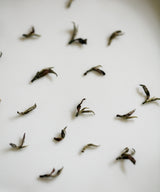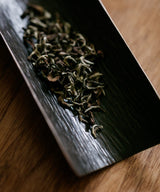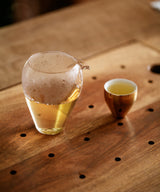Oriental Beauty Gold 東方美人
東方美人
Harvest
June 2023
Origin
E'mei, Hsinchu, Taiwan
On my recent trip to Taiwan I was fortunate to source two grades of Oriental Beauty, crafted by a 76-years old tea master. One won the Gold Medal Award at the Annual Hsinchu Oriental Beauty Competition, and the other won the Bronze Medal Award. These teas exemplify what makes Oriental Beauty so sought after and so highly regarded in the world of tea.
In this highest grade of Oriental Beauty we notice smaller, more condensed leaves. In the dried tea, we clearly see one tip and one bud. It is difficult to imagine that each leaf and bud was picked by hand, they are so tiny and delicate.
The aroma of this tea has the same sweet, earthy bass layer as the Bronze, but with an extra-dimensional complex set of top notes, which caused us to describe it comparatively as “more 3D.”
The tea brews a champagne coloured liquor, much lighter than the Bronze tea. Its taste is bursting with life, like spring flowers and magnolia. It has a robust aquatic quality, like water lotus: a unique bouquet supported by the earthiness of the tea itself.
After the first infusion the lid of the gaiwan smells like what we think angel wings might smell like, were you to bury your face in them.
The second infusion plunges us deeper into this tea’s serene world of pond notes: we taste petals, moss, and wet stone. The soft mouthfeel invites pause, and we hold it on our palates for a moment before swallowing.
We notice that, as we drink this Oriental Beauty, it opens the imagination. Whole images and scenarios come to us as we sip it, and our minds wander through them. We recall the truth in our initial impression of its taste: that it really is extra-dimensional.
After several infusions the wet leaves look entirely like an aquatic plant. They are a rich, uniform, oxidized red – waxy, winding, and wholly intact.
. . .
Oriental Beauty is a tea that occupies a category of its own. It is well known as a rare and precious tea, often commanding the highest prices of all teas from Taiwan.
There are a few reasons why Oriental Beauty carries both this value and reputation.
Firstly, it is entirely made from leaves that are bitten by a small fly. The bite from the fly is what begins this oolong’s process of oxidation, allowing it to happen while the leaves are still on the tree! We can attribute Oriental Beauty’s very unique and sweet characteristics to this little fly.
Secondly, like all highly prized tea, terroir is extremely important to Oriental Beauty. True Oriental Beauty will only come from one of two small villages, Beipu and E’mei. of Hsin Chu County. These two villages combined have an area of 90 km², (to put that in perspective, the city of Vancouver is 114 km²!)
Lastly, Oriental Beauty is extremely labour intensive to harvest and craft. The highest grades are made exclusively of the smallest and youngest one-bud-one-leaf. These tender leaves are very hard to pick. In one full day of harvesting, a skilled tea picker will only collect between 75 and 100 grams of fresh leaves. Thus, it takes 8 to 10 skilled tea pickers an entire day to collect enough leaves to make 500 grams of Oriental Beauty. As you can quickly calculate, the labour costs for Oriental Beauty are amongst the highest of all teas in the world.
. . .
Brewing guide
| Tea | 2g |
| Temperature |
90 °C |
| Water | 120ml |
| Steep time | 30 - 90 sec |
| No. of infusions | 8 |
















